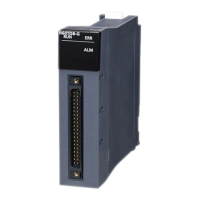1152
10 PID CONTROL INSTRUCTIONS
10.1 Overview
*1 When the PID limit is restricted
*2 When the PID limit is not restricted
*3 For PID control (inexact differential) only
Data for each loop Operational
expression selection
Selects direct action or reverse action. 0: Direct action
1: Reverse action
An error occurs, and PID operation
is not performed for the
corresponding loop.
Sampling period (T
S
) Sets a cycle of PID operation. 1 to 6000 (in increments
of 10ms)
Proportional constant
(K
P
)
A constant of proportionality in PID
operation
1 to 10000 (in increments
of 0.01)
Integral constant (T
I
) A constant that expresses the magnitude of
the integral action effect. Increasing the
integral constant slows down the variation in
the manipulated value.
1 to 32767 (in increments
of 100ms)
Derivative constant
(T
D
)
A constant that expresses the magnitude of
the derivative action effect. Increasing the
derivative constant causes a significant
change in the manipulated value even with
slight change of the control objective.
0 to 30000 (in increments
of 10ms)
Filter coefficient () Degree of filtering applied to the process
value (input value from the A/D converter
module). The filtering effect decreases as
the value gets closer to 0.
1 to 100
Manipulated value
lower limit (MVLL)
Lower limit of the manipulated value (MV)
calculated by PID operation in automatic
mode. If the MV is smaller than the MVLL,
the MVLL is used as the MV.
-50 to 2050
*1
In the case of *1, if the MVLL or
MVHL value is out of the valid
range, it will be converted as
follows.
• If the value is smaller than -50, -
50 is used.
• If the value is bigger than 2050,
2050 is used.
-32768 to 32767
*2
Manipulated value
upper limit (MVHL)
Upper limit of the manipulated value (MV)
calculated by PID operation in automatic
mode. If the MV is bigger than the MVHL,
the MVHL is used as the MV.
-50 to 2050
*1
-32768 to 32767
*2
Manipulated value
variation rate limit
(MVL)
Limit of variation in the manipulated values
calculated last time and this time. If the
variation exceeds the limit, 1 is set to b1 of
the alarm device.
Note that the variation amount will not be
limited actually. Even if the variation
exceeds the limit, it is used as it is, and the
MV is calculated.
0 to 2000
*1
In the case of *1, if the MVL or
PVL value is out of the valid
range, it will be converted as
follows.
• If the value is smaller than 0, 0 is
used.
• If the value is bigger than 2000,
2000 is used.
0 to 32767
*2
Process value
variation rate limit
(PVL)
Limit of variation in the process values input
last time and this time. If the variation
exceeds the limit, 1 is set to b0 of the alarm
device.
Note that the variation amount will not be
limited actually. Even if the variation
exceeds the limit, it is used as it is, and the
PID operation is performed.
0 to 2000
*1
0 to 32767
*2
Derivative gain (K
D
)
*3
A time period (operation delay) for
derivative action. The time period
decreases as the value gets bigger. (The
operation becomes closer to exact
differential.)
0 to 32767 (in increments
of 0.01)
An error occurs, and PID operation
is not performed for the
corresponding loop.
Type Item Description Setting range Processing when set data is
out of the valid range

